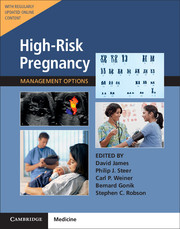Book contents
- Frontmatter
- Contents
- List of Contributors
- Preface
- Section 1 Prepregnancy Problems
- Section 2 Early Prenatal Problems
- Section 3 Late Prenatal – Fetal Problems
- 9 Prenatal Fetal Surveillance
- 10 Fetal Growth Disorders
- 11 Disorders of Amniotic Fluid
- 12 Fetal Hemolytic Disease
- 13 Fetal Thrombocytopenia
- 14 Fetal Cardiac Arrhythmias
- 15 Fetal Cardiac Abnormalities
- 16 Fetal Craniospinal and Facial Abnormalities
- 17 Fetal Genitourinary Abnormalities
- 18 Fetal Gastrointestinal and Abdominal Abnormalities
- 19 Fetal Skeletal Abnormalities
- 20 Fetal Tumors
- 21 Fetal Hydrops
- 22 Fetal Death
- Section 4 Problems Associated with Infection
- Section 5 Late Pregnancy – Maternal Problems
- Section 6 Late Prenatal – Obstetric Problems
- Section 7 Postnatal Problems
- Section 8 Normal Values
- Index
9 - Prenatal Fetal Surveillance
from Section 3 - Late Prenatal – Fetal Problems
- Frontmatter
- Contents
- List of Contributors
- Preface
- Section 1 Prepregnancy Problems
- Section 2 Early Prenatal Problems
- Section 3 Late Prenatal – Fetal Problems
- 9 Prenatal Fetal Surveillance
- 10 Fetal Growth Disorders
- 11 Disorders of Amniotic Fluid
- 12 Fetal Hemolytic Disease
- 13 Fetal Thrombocytopenia
- 14 Fetal Cardiac Arrhythmias
- 15 Fetal Cardiac Abnormalities
- 16 Fetal Craniospinal and Facial Abnormalities
- 17 Fetal Genitourinary Abnormalities
- 18 Fetal Gastrointestinal and Abdominal Abnormalities
- 19 Fetal Skeletal Abnormalities
- 20 Fetal Tumors
- 21 Fetal Hydrops
- 22 Fetal Death
- Section 4 Problems Associated with Infection
- Section 5 Late Pregnancy – Maternal Problems
- Section 6 Late Prenatal – Obstetric Problems
- Section 7 Postnatal Problems
- Section 8 Normal Values
- Index
Summary
Introduction
Modern antenatal care aims to optimize both maternal and fetal outcomes. The various methods of prenatal fetal surveillance are directed towards early detection and, sometimes, prevention of chronic fetal hypoxia. The fetal response to acute or chronic hypoxia varies and is modified by the preceding fetal condition. Prenatal fetal surveillance tools are useful in pregnancies that are at high risk of developing chronic fetal hypoxia, but less so for acute events (e.g., placental abruption). There is evidence that fetal surveillance in unselected low-risk population is not cost-effective and leads to unnecessary interventions. Therefore routine prenatal fetal surveillance techniques or tests are not universally adopted in this group.
Normal Fetal Physiology and In Utero Adaptive Responses
The in utero environment is relatively hypoxic, but fetal adaptive mechanisms ensure adequate tissue oxygenation. Fetal hemoglobin, which has a greater affinity for oxygen than adult hemoglobin, facilitates placental oxygen uptake by fetal blood, and increased oxygen saturation for a given arterial partial pressure of oxygen. Furthermore, the fetus maintains high blood flow to tissues as a result of high cardiac output, while the venous return from the placenta is directed to the most oxygen-demanding organs, through anatomic shunting. The oxygenated fetal blood returning from the placenta through the umbilical vein bypasses the fetal liver via the ductus venosus to reach the fetal heart, and then through the formen ovale or the ductus arteriosus to reach the aortic outflow. These anatomic shunts ensure that the most oxygenated blood is channeled with the least delay to the most important organs, including the brain, adrenal glands, and heart.
Transient decreases in oxygenation are common when there is a temporary interruption in uterine or umbilical blood flow. During these events, the fetus is normally able to maintain aerobic metabolism until the available oxygen in the intervillous space falls below 50% of normal levels. In addition, in response to the hypoxia triggers the fetal heart rate reduces temporarily, which acts as a compensatory mechanism by reducing tissue oxygen consumption.
In acute fetal hypoxia, the usual aerobic metabolism gives way to anaerobic metabolism, which if it persists leads to metabolic acidosis and acidemia. If normal fetal oxygenation does not resume, metabolic acidosis progresses to asphyxia, leading to loss of fetal adaptive mechanisms. This worsens the response to ongoing hypoxia and finally leads to myocardial depression, loss of autoregulation in cerebral blood flow, and ischemic brain injury.
- Type
- Chapter
- Information
- High-Risk Pregnancy: Management OptionsFive-Year Institutional Subscription with Online Updates, pp. 207 - 225Publisher: Cambridge University PressFirst published in: 2017



